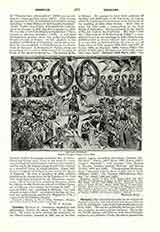

Orcagna (the conventional name in art history of ANDREA DI CIONE, also called ARCAONIIOLO Or ARCANGM); b. at Florence, early in the fourteenth century; d. there, 1368. The son of a goldsmith, he became architect, sculptor, mosaist, painter, and poet. His brothers, Nardo, Jacopo, and Matteo, were also architects, sculptors, and painters: Nardo, the eldest, painted the famous fresco of “The Last Judgment”, still to be seen in the Strozzi chapel in S. Maria Novella, a composition inspired by the “Divina Commedia”, and comprising the Judgment, Paradise, and Hell as its three parts. This fresco has been erroneously attributed to Andrea, who became the most famous of the Cioni, but Lorenzo Ghiberti testifies to its being the work of Nardo. In the same way, the “Triumph of Death” and “The Last Judgment” in the Campo Santo of Pisa, owing to their similarity to the S. Maria Novella fresco, used to be attributed to Nardo and Andrea di Cione. Both these brothers were registered in the Florentine Guild of Painters in 1357. In that year Andrea (Orcagna) collaborated with Francesco di Talento on plans for the enlargement of S. Maria del Fiore. In 1358 he executed mosaics for the facade of the cathedral of Orvieto. Vasari makes Andrea Pisano his master in the art of sculpture, but this honor is more probably due to Neri di Fieravante, his sponsor when he matriculated in the Guild of “masters of stone and wood”, in 1352.
According to Vasari, the Brotherhood of Orsammichele took the offerings made to the Blessed Virgin during the plague of 1348 and used them to build around her image an elaborately ornamented marble tabernacle. Orcagna was entrusted with this work, which he completed in 1359. For brilliancy and richness of architecture as well as of decoration, Burckhardt regards this tabernacle as the most perfect work of its kind in Italian Gothic. The mysteries of the life of the Blessed Virgin are represented in bas-relief with a series of allegorical figures of the Virtues. The Announcement of Mary’s Death and the Assumption are especially worthy of note. This tabernacle of Orsammichele is Orcagna’s only authentic sculptural work, but his manner is discernible in the “Annunciation” of Santa Croce and in the bas-reliefs of the Campanile of S. Maria del Fiore which represent the Virtues and Liberal Arts.
The chief paintings of Orcagna which have survived are: a St. Matthew, painted, in collaboration with his brother Jacopo, for S. Maria Novella, now in the Uffizi; a “Virgin with Angels”, in the Somzee collection at Brussels; a “Vision of St. Bernard”, in the Academy of Florence; a “Coronation of the Virgin”, executed for San Pier Maggiore, Florence, now in the National Gallery, London. In 1357 Tommaso di Rossello Strozzi commissioned Orcagna to paint an altar-piece for the same chapel in which Nardo had painted the frescoes. This retable is divided into five parts: in the center Christ is enthroned, a pyramidal crown on his brow, two little angels at his feet, playing music; at Christ’s right hand is the Blessed Virgin, presenting St. Thomas Aquinas to Him; at His left hand is the Precursor who indicates Christ to a kneeling St. Peter. In the last two compartments are seen, on one side St. Lawrence and St. Paul, on the other St. Michael and St. Catherine. Orcagna was commissioned in the following year to paint the life of the Blessed Virgin on the walls of the choir of S. Maria Novella. These paintings were ruined by damp, owing to a leaking roof, but were restored by Ghirlandajo who drew his inspiration from the happy “inventions of Orcagna” (Vasari).
GASTON SORTAIS

